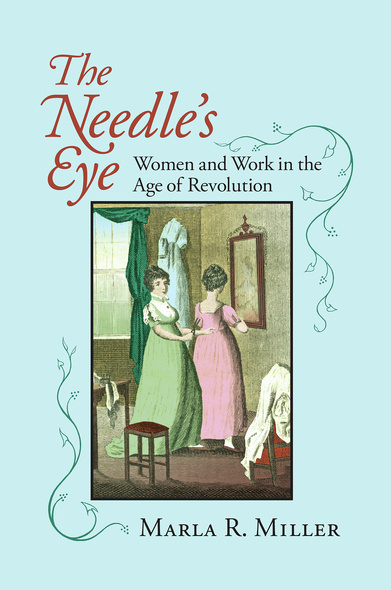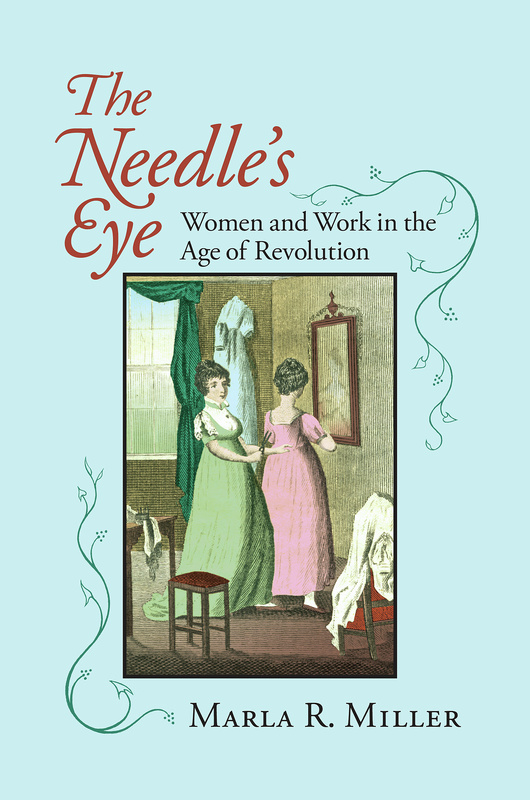The Needle's Eye
Women and Work in the Age of Revolution
University of Massachusetts Press
Among the enduring stereotypes of early American history has been the colonial Goodwife, perpetually spinning, sewing, darning, and quilting, answering all of her family's textile needs. But the Goodwife of popular historical imagination obscures as much as she reveals; the icon appears to explain early American women's labor history while at the same time allowing it to go unexplained. Tensions of class and gender recede, and the largest artisanal trade open to early American women is obscured in the guise of domesticity.
In this book, Marla R. Miller illuminates the significance of women's work in the clothing trades of the early Republic. Drawing on diaries, letters, reminiscences, ledgers, and material culture, she explores the contours of working women's lives in rural New England, offering a nuanced view of their varied ranks and roles—skilled and unskilled, black and white, artisanal and laboring—as producers and consumers, clients and craftswomen, employers and employees. By plumbing hierarchies of power and skill, Miller explains how needlework shaped and reflected the circumstances of real women's lives, at once drawing them together and setting them apart.
The heart of the book brings into focus the entwined experiences of six women who lived in and around Hadley, Massachusetts, a thriving agricultural village nestled in a bend in the Connecticut River about halfway between the Connecticut and Vermont borders. Miller's examination of their distinct yet overlapping worlds reveals the myriad ways that the circumstances of everyday lives positioned women in relationship to one another, enlarging and limiting opportunities and shaping the trajectories of days, years, and lifetimes in ways both large and small. The Needle's Eye reveals not only how these women thought about their work, but how they thought about their world.
In this book, Marla R. Miller illuminates the significance of women's work in the clothing trades of the early Republic. Drawing on diaries, letters, reminiscences, ledgers, and material culture, she explores the contours of working women's lives in rural New England, offering a nuanced view of their varied ranks and roles—skilled and unskilled, black and white, artisanal and laboring—as producers and consumers, clients and craftswomen, employers and employees. By plumbing hierarchies of power and skill, Miller explains how needlework shaped and reflected the circumstances of real women's lives, at once drawing them together and setting them apart.
The heart of the book brings into focus the entwined experiences of six women who lived in and around Hadley, Massachusetts, a thriving agricultural village nestled in a bend in the Connecticut River about halfway between the Connecticut and Vermont borders. Miller's examination of their distinct yet overlapping worlds reveals the myriad ways that the circumstances of everyday lives positioned women in relationship to one another, enlarging and limiting opportunities and shaping the trajectories of days, years, and lifetimes in ways both large and small. The Needle's Eye reveals not only how these women thought about their work, but how they thought about their world.
This is a wonderful book. It exemplifies prodigious research and unusually creative reading and linking of primary documents. . . . The Needle's Eye is an important addition to New England history, labor history, and women's history. . . . Throughout, the writing is polished, accessible, and filled with the kind of detail that brings a world to life.Journal of Social History—Laurel Thatcher Ulrich, Harvard University
'Marla Miller's book will inspire similar studies of women's needlework in other regions of the country and, along with Laurel Thatcher Ulrich's The Age of Homespun, be the beginning of a much more thorough understanding of women's early labor history.'—Lynne Z. Bassett, The Connecticut Historical Society
'This is an excellent study of an important topic. . . . It will engage scholars and students in early American history and also be accessible for general readers interested in women's history, material culture, and social life in the period of the American Revolution. . . . In short, this is a rich and significant book.'—Christopher Clark, University of Connecticut
'Many of the relevations of Needle's Eye are startling, not least among them the weeks of labor required to make a man's coat from start to finish in the late 1700s.'—UMass Amherst Magazine
'This careful, richly detailed study unravels and reconstructs the working lives of unknown and unsung real women who plied the needle in the midst of multiple revolutions. . . .Miller reconstructs a complex world of women's work and relationships. She finds intersecting and overlapping spheres of household and community expressive of dense webs of connections shaping women's needlework within a changing marketplace. Particularly impressive is her reading of account books, documents that can pose narrative challenges. Out of countless transactions, Miller weaves together detailed portraits of women's needlework, their positions in communities, and their changing stations over time. . . .Well grounded in place and in the spaces in which women moved and worked, this book represents a solid addition to our understanding of women's laboring lives and interactions against the backdrop of revolutionary changes.'—American Historical Review
'In this impressive book, Miller brings together the insights of women's, labor and social history to make her readers think anew about topics we thought we already understood. '¦ Miller does a stellar job of complicating the history she tells, and she almost never loses the reader in the complex story she weaves.'—New England Quarterly
'[The Needle's Eye is] witty, highly readable, and meticulously documented study. . . on the whole Miller accomplishes what she set out to do: show 'how assumptions about gender and work evolved during a period of remarkable flux.''—Technology and Culture
'The Needle's Eye reveals the previously overlooked work of women in the clothing trade in the late eighteenth and early nineteenth centuries. Though Miller grounds her study in the particulars of the upper Connecticut River valley, she connects the local evidence to larger historical questions. . . . In reconstructing the 'communities of practice,' Miller furnished wonderful insights into the world of clothing. . . . The Needle's Eye is a clear, well-written account of female needlework in the late colonial and early national periods.'—William and Mary Quarterly
'This is an impressively - indeed, beautifully - researched book.'—Journal of the Early Republic
'This is a book that does justice to its subject. The Needle's Eye is a meticulous, nuanced account fo the many varities of needlework that engaged the energies of women in eighteenth-century and early nineteenth-century rural New England. Indeed, it demonstrates that its author is as talented a practitioner of her craft (history) as the most skilled of her protagonists were of theirs. Marla R. Miller combines impressive expertise in material culture with smart reading of fragmentary docmentary exidence to recover a vibrant social and economic world rendered largely invisible by nostalgia for an imagined colonial past.'—Journal of Social History
'Marla R. Miller's account offers a broad perspective, viewing needlework as both paid and unpaid work, exploring both its economic and social dimensions in village life from roughly the mid-eighteenth century through the first quarter of the nineteenth century. She also brings to the topic a sensitivity to its material culture dimensions which is particularly valuable. . . . As material culture study, social history, and intellectual history, The Needle's Eye has much to say to American studies scholars today. . . . Miller makes a real contribution by viewing artisan work through a gendered lens, reminding all in the historical trade of the value of this new perspective.'—Project MUSE
Marla R. Miller is associate professor of history and director of the Public History Program at the University of Massachusetts Amherst.





